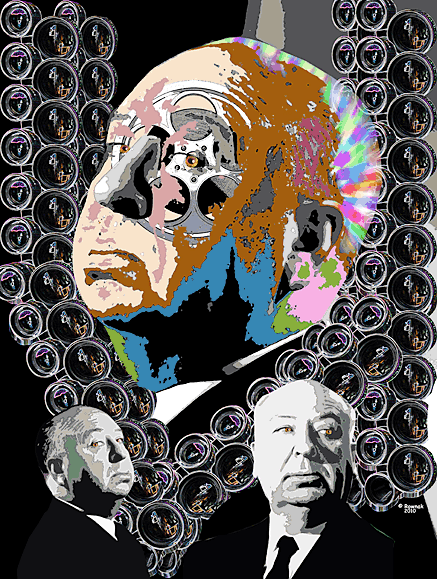Art for a visual hungry world

Want me to do a pop-art portrait for you? Send me an EMAIL and lets talk!
| Alfred
Hitchcock Biography in full Sir Alfred Joseph Hitchcock ( 1899 – 1980 ) (born Aug. 13, 1899, London—died April 29, 1980, Bel Air, Calif., U.S.) English-born motion-picture director whose suspenseful films won immense popularity. The son of a London poultry dealer, Hitchcock attended St. Ignatius College, London, and the University of London, where he studied engineering. In 1920 he began to work in the motion-picture industry, designing title cards for the Famous Players-Lasky Company. Within a few years he had become a scenario writer and an assistant director, and he directed his first film ( The Pleasure Garden) in 1925. With The Lodger (1926), the story of a family who mistakenly suspect their roomer to be Jack the Ripper, Hitchcock began making the “thrillers” with which he was to become identified. His Blackmail (1929) was the first successful British talking picture. During the 1930s he directed such classic suspense films as The Man Who Knew Too Much (1934), The Thirty-nine Steps (1935), Sabotage (1936), and The Lady Vanishes (1938). In 1939 Hitchcock left England for Hollywood, where his first film, Rebecca (1940), won an Academy Award for best picture. During the next three decades Hitchcock usually made a film a year in the Hollywood motion-picture system. Among the important films he directed during the 1940s were Suspicion (1941), Shadow of a Doubt (1943), Lifeboat (1944), Spellbound (1945), and Rope (1948). He began functioning as his own producer in 1948, and he went on in the 1950s to make a series of big-budget suspense films starring some of the leading actors and actresses of Hollywood. These films include Strangers on a Train (1951), Dial M for Murder (1954), Rear Window (1954), To Catch a Thief (1954), The Man Who Knew Too Much (1955; a remake of the 1934 film), Vertigo (1958), and North by Northwest (1959). In the 1960s Hitchcock turned to making thrillers with new and original emphases, among them Psycho (1960), The Birds (1963), and Marnie (1964). His Torn Curtain (1966) and Topaz (1969) are conventional espionage stories, while in his last films, Frenzy (1972) and Family Plot (1976), he returned to his original themes. From the 1940s on Hitchcock usually made a fleeting, wordless appearance in a bit part in each of his films. Hitchcock's
films usually centre on either murder or espionage, with deception,
mistaken identities, and chase sequences complicating and enlivening
the plot. Wry touches of humour and occasional intrusions of the macabre
complete this mixture of cinematic elements. Three main themes predominate
in Hitchcock's films. The most common is that of the innocent man
who is mistakenly suspected or accused of a crime and who must then
track down the real perpetrator in order to clear himself. Examples
of films having this theme include The Lodger, The Thirty-nine Steps,
Saboteur, Strangers on a Train, I Confess, To Catch a Thief, The Wrong
Man, North by Northwest, and Frenzy. The second theme is that of the
guilty woman who enmeshes a male protagonist and ends up either destroying
him or being saved by him; examples of this theme include Blackmail,
Sabotage, Notorious, Rebecca, Vertigo, and Marnie. The third theme
is that of the (frequently psychopathic) murderer whose identity is
established during the working out of the plot; examples of this theme
include Shadow of a Doubt, Rope, Rear Window, and Psycho. The psychopathic
killer theme may sometimes be combined with the plot of the falsely
accused innocent man, as in Frenzy. Hitchcock produced several popular American television series in the 1950s and '60s, which he introduced and sometimes directed. His name also appeared on a series of mystery-story anthologies. He received the American Film Institute's Life Achievement Award in 1979 and was knighted by Queen Elizabeth II in 1980. Copyright © 1994-2010 Encyclopædia Britannica, Inc. For more information visit Britannica.com
|